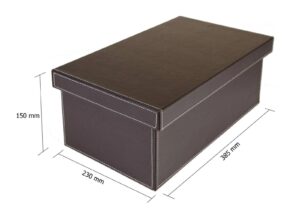
Shoe boxes are part of the shoe industry. They not only help protect the product while the packaging is in service but also present it attractively. For a shoe lover, a retailer, or anyone arranging their wardrobe, knowledge of standard shoe box sizes in centimetres would really come in handy. This article will go ahead to delve into the dimensions of standard shoe boxes in CM, factors that influence their sizes, and why they matter in other contexts.
What is a standard shoe box?
A standard shoe box is a container designed for housing a pair of shoes that allows protection and convenience during storage and transportation. Even though generally no universally agreed size is there, most manufacturers follow general guidelines to cater to different kinds of footwear.
Standard Shoe Box Sizes in CM
Size of an Adult Shoe Box
Most adult shoes come in standard dimensions as follows
Length: 33 cm Width: 21 cm 12 cm
Of course, different types of shoe may vary in size. Athletes and sneakers might require bigger size boxes because of the stocky build of their designs.
Children’s Shoe Box Dimensions
The children’s shoe boxes are of smaller sizes to accommodate the shorter length of the shoe:
Length: 25 cm
Width: 17 cm
Height: 10 cm
These small sizes not only are handy for holding some smaller shoes but also use fewer materials and resources as well as minimize the environmental footprint.
Specialty Shoe Box Dimensions
Boots, high heels and specially designed footwear are all in irregular sizes.
High Heel Boxes: A bit more taller than the average height, these high-heeled boxes measure around 35 cm by 22 cm by 14 cm.
Factors Influencing Shoe Box Dimensions
Numerous factors determine shoe box dimensions:
Shoe Type
There are various types of shoes, and they all have different box requirements as follows:
Sneakers involve bigger cushioning and so need a larger box, whereas sandals do not require much cushioning and can fit into more slender boxes.
Target Audience
The shoe box size is based on the age group and foot size of the target audience. A child’s shoe is packed in a smaller shoe box, while adult footwears are packed in bigger sizes.
Local Norms
Some countries may have specific sizes for shoe boxes, which comply with shipment or retail purpose, for example.
Why Do You Need to Know About Shoe Box Sizes?
Knowing the standard shoe box size has the following use value:
Storage and Organizing
Shoe boxes are easier to arrange and stack if they are of standard size; it could be in a retail or in your home. Knowing the dimension helps you optimize your space for storage.
Shipping and Logistics
For retailers and manufacturers, the knowledge of shoe box dimensions is essential for efficient shipping. The proper use of correctly sized boxes saves packing materials and reduces shipping costs.
Eco-Friendliness
Standard sizes minimize wastage. A box that is too large for its contents means wasting unnecessary material and creating excess environmental impact.
Presentation and Branding
A designer shoe box protects the product not only physically but also through enhancing the unboxing experience of the customer. Knowing the right size helps create both functional and visually appealing packaging.
Tips for Choosing the Right Shoe Box Size
If you’re a retailer, manufacturer, or just someone packaging shoes for storage or gifting, here are some tips to consider:
Measure the shoes
At all times measure the length, width, and height of the shoe to get an appropriate box size.
Provide for extra space
Account for the little amount of protective material like tissue paper or even padding
Ensure it is the type of shoe: The boots, heels, and sneakers require custom-sized boxes.
Look at standard sizes
Use the most accepted dimension for efficiency and consistency with whatever storage system
Differences in Shoe Box Designs
Apart from size, shoe boxes vary in design based on functionality and branding:
Flip-Top Boxes
These are common for casual and athletic shoes. The lid is attached, making it easy to open and close.
Two-Piece Boxes
Typically used for formal or luxury footwear, these boxes contain a separate base and lid, offering a premium feel.
Drawer-Style Boxes
These are innovative and functional, allowing easy access to the shoes without removing the box from a stack.
Conclusion
Understanding the standard size of the shoe box in CM is more than just a trivial detail; it’s a key factor in storage, shipping, and presentation. Although the most common dimensions for adult shoe boxes are approximately 33 cm x 21 cm x 12 cm, their dimensions vary based on the shoe type and target audience.
Whether you’re organizing a closet or are a business looking to perfect packaging, knowing these standard dimensions can help you make the right decision in the process. With the proper size of the boxes, you can increase efficiency, reduce waste, and heighten the overall user experience.
